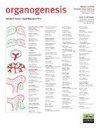HIF-1α和HIF-2α在组织再生中的表达及作用:缺氧对壁虎尾部再生的研究
IF 2.8
4区 生物学
Q4 BIOCHEMISTRY & MOLECULAR BIOLOGY
引用次数: 14
摘要
摘要:家壁虎(鸭嘴兽半指)已经进化出在受到威胁时能够自我交配的能力。然后,在需要高能量和高氧气水平的过程中,损失的部分通过表观再生再生再生。因此,氧气需求可能超过供应,这可能导致再生尾巴组织相对缺氧。缺氧状态由缺氧诱导因子-1α(HIF-1α)和HIF-2α蛋白稳定。我们使用标准程序在30只成年鸭嘴兽中诱导尾部自残,然后在自残后第1、3、5、8、10、13、17、21、25和30天收集再生的尾部组织样本。对于每个样本,通过qPCR分析mRNA表达,使用Western印迹试验和免疫组织化学分析蛋白质,并使用苏木精和曙红染色分析组织学结构。第1天,HIF-1αmRNA表达增加,组织以白细胞和红细胞为主。HIF-1αmRNA表达在第3天达到峰值,此时一些细胞正在积极增殖、迁移和分化。在HIF-1α表达减少的同时,HIF-2αmRNA表达增加,整体细胞活性也增加。与HIF-1α相比,HIF-1α的表达逐渐增加,但存在时间更长。我们假设HIF-1α有助于最初刺激组织再生过程,而在HIF-1α屈服于氧气条件后,HIF-1α在功能上接管了HIF-1α的作用,但我们怀疑HIF-1α和HIF-2α都在克服组织缺氧状态中发挥作用。本文章由计算机程序翻译,如有差异,请以英文原文为准。
Expression and role of HIF-1α and HIF-2α in tissue regeneration: a study of hypoxia in house gecko tail regeneration
ABSTRACT The house gecko (Hemidactylus platyurus) has evolved the ability to autotomize its tail when threatened. The lost part is then regrown via epimorphic regeneration in a process that requires high energy and oxygen levels. Oxygen demand is therefore likely to outstrip supply and this can result in relative hypoxia in the tissues of the regenerating tail. The hypoxic state is stabilized by the Hypoxia Inducible Factor-1α (HIF-1α) and HIF-2α proteins. We induced tail autotomy in 30 mal H. platyurus adults using a standard procedure and then collected samples of the regenerated tail tissue on days 1, 3, 5, 8, 10, 13, 17, 21, 25, and 30 post autotomy. For each sample, mRNA expression was analyzed by qPCR, proteins were analyzed using Western Blot tests and immunohistochemistry, and the histological structure was analyzed using Hematoxylin and Eosin staining. On day 1, HIF-1α mRNA expression increased and the tissue was dominated by leucocyte and erythrocyte cells. HIF-1α mRNA expression peaked on day 3, at which time some cells were actively proliferating, migrating, and differentiating. At the same time as HIF-1α expression decreased, HIF-2α mRNA expression increased, as did overall cellular activity. HIF-2α expression increased more gradually but was present over a longer period of time than HIF-1α. We hypothesize that HIF-1α helps to initially stimulate the tissue regeneration process while HIF-2α functionally takes over the role of HIF-1α after HIF-1α succumbs to the oxygen conditions, but we suspect that both HIF-1α and HIF-2α play a role in overcoming the tissue’s hypoxic state.
求助全文
通过发布文献求助,成功后即可免费获取论文全文。
去求助
来源期刊

Organogenesis
BIOCHEMISTRY & MOLECULAR BIOLOGY-DEVELOPMENTAL BIOLOGY
CiteScore
4.10
自引率
4.30%
发文量
6
审稿时长
>12 weeks
期刊介绍:
Organogenesis is a peer-reviewed journal, available in print and online, that publishes significant advances on all aspects of organ development. The journal covers organogenesis in all multi-cellular organisms and also includes research into tissue engineering, artificial organs and organ substitutes.
The overriding criteria for publication in Organogenesis are originality, scientific merit and general interest. The audience of the journal consists primarily of researchers and advanced students of anatomy, developmental biology and tissue engineering.
The emphasis of the journal is on experimental papers (full-length and brief communications), but it will also publish reviews, hypotheses and commentaries. The Editors encourage the submission of addenda, which are essentially auto-commentaries on significant research recently published elsewhere with additional insights, new interpretations or speculations on a relevant topic. If you have interesting data or an original hypothesis about organ development or artificial organs, please send a pre-submission inquiry to the Editor-in-Chief. You will normally receive a reply within days. All manuscripts will be subjected to peer review, and accepted manuscripts will be posted to the electronic site of the journal immediately and will appear in print at the earliest opportunity thereafter.
 求助内容:
求助内容: 应助结果提醒方式:
应助结果提醒方式:


